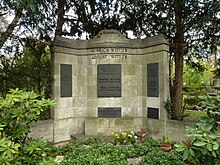Wittler (baker)
Wittler was a large Berlin bakery . In the period after the First World War, it was the largest bread producer in Europe with 2000 employees. The company went bankrupt in 1982.
history
Wittler was founded in 1898 by Heinrich Wittler as a bakery with two additional journeymen on the corner of Müllerstrasse and Utrecht Strasse in the Wedding district . Wittler expanded quickly. In 1908 the company moved to Maxstrasse in Wedding. In 1914, 120 bread-making workers worked there. The bakery was the first in Berlin to use industrial processes to produce bread in large quantities. During the First World War, the company worked as a producer for the Reichsmarine . Heinrich's brother August founded a competing bakery, which in 1916 merged with Heinrich's bakery to form Wittler GmbH. Soon afterwards August took over the management of the company and pushed Heinrich into representative positions.
After the First World War, Wittler was at times the largest bread producer in Europe with up to 2000 employees. These delivered the bread to 30 of their own sales outlets in the Berlin urban area.
August Wittler and Stefan Steinmetz founded the Steinmetz bread factory in Berlin in 1919, which still supplies customers throughout the German-speaking area.
Wittler had good contacts with the NSDAP during the National Socialist era and thus supplied the 1936 Summer Olympics with baked goods. Wittler made the so-called commissary bread for the Reichswehr . During the Second World War, two thirds of the workforce consisted of forced laborers who were housed in Wittler's own camps. In the 1940s, 5000 tons of flour were processed daily, which were brought to a total of 9000 sales outlets in Berlin and the surrounding area.
After the Second World War, August Wittler was imprisoned in the Sachsenhausen special camp , where he died in 1946. The company was temporarily confiscated and dismantled. The factories were located in West Berlin and were returned to the owners. Two thirds of the sales branches were in the eastern part of the city and Wittler lost them. In 1949 the company went back to the family and Herbert Wittler became managing director.
After the Second World War, Wittler suffered from changing eating habits, which caused the consumption of bread to decline. The then company boss Herbert Wittler complained: The sausage is getting thicker and thicker, the bread is getting thinner and thinner. The company was able to hold onto the market until 1982, but went bankrupt due to increasing competition from West German producers.
Construction of the bread factory
Wittler had the bread factory built in 1927/1928 by the architect Kurt Berndt . The six-storey bakery was built according to the most modern methods of the industrial production of bread. The underlying processes were developed at the Research Institute for Grain Processing in the nearby Weddinger Seestrasse . The raw materials were delivered to the sixth floor in order to produce the bread in several successive work processes, with a different process taking place on each floor. From the silo on the upper floor, the ingredients fell one level down and were sifted and mixed in order to be processed into dough one level down. After fermentation , the bread was baked and cooled in three ovens before it was finally packaged and delivered on the ground floor. Wittler was able to produce up to 66,000 pieces of bread a day.
Delivery vehicles
In order to supply the sales outlets, Wittler maintained its own fleet of vehicles. This originally consisted of horse and carts, for which the company had over 300 horses. In the 1920s, Wittler switched to electric cars , which stood out in the urban area with their typical red-brown design. Wittler operated around 10 of these vehicles during World War II. On the delivery truck was the advertising slogan: "Wittler bread ... eat regularly!".
Only a few of the former delivery vehicles from Wittler have survived. A fully functional electric truck is being restored by Wittler for the European Bread Museum in Ebergötzen in the Göttingen district . Another is owned by the German Museum of Technology in Berlin; it was restored by students at the Berlin University of Technology and Economics .
The bread factory
The former bakery and the administration wing of the Wittler bread factory still stand today. These are now used by a health and care center. The rear factory buildings were demolished in the 1980s in order to build social housing on the site. The main building is a five-storey steel frame building , which is joined by the bakery as a central wing. This towers over the main building with a polygonal broken gable. The facade is structured by dark red brick sections and white plastered sections. Ceramic reliefs on the central axes of the building depict the making of bread.
Web links
Individual evidence
- ↑ a b c d LDA Berlin: Wittler bread factory
- ↑ a b c d e f BBWA: Bread baking with gravity , Berliner Wirtschaft 3/15 p. 66
- ↑ a b c Petra Ahne: Tresor contained the true Wittler story , Berliner Zeitung May 14, 1999
- ↑ finding aid in the Berlin State Archive: Wittlers bread factories accessed, April 7, 2020
- ↑ a b Der Wittler-Brotwagen , Hochschule für Technik und Wirtschaft Berlin, accessed on April 7, 2020
- ↑ enz: Donation from the energy supplier Eon enables restoration , Göttinger Tageblatt July 15, 2010
literature
- Andrea Lefèvre: The Wittler bread factory in: Geschichtslandschaft , Wedding, 1990, pages 189-208
- 55 years of August Wittler Brotfabrik Kommanditgesellschaft In: Internationale Industrie-Bibliothek , Volume 96, Brilon, around 1955.
Coordinates: 52 ° 32 '55.8 " N , 13 ° 21' 59.7" E


